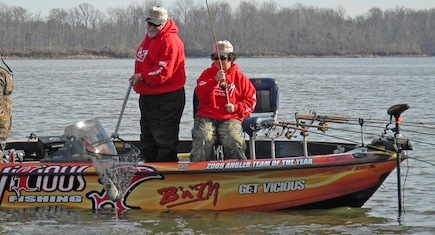Starting out of the cove, I am interested in small clips that Barbara Reedy uses to hold the line in place on pre-strung crappie poles in the stern mounted rack. Most anglers twist the line around the guides to keep poles from becoming entangled. She explains that they are hair clips and just the right size for this job.
One of the country’s most successful professional crappie fishing teams, Barbara and husband Jim are masters of fishing with spider rigs.
We met on a lake near the Reedy home base of Charleston, Mo., for a morning of crappie fishing using spider rigs.
With two anglers in the boat there is a division of labor that proves successful for over past nearly 20 years of crappie fishing. They have been competing in tournaments for 18 years.

Jim Reedy nets Barbara's fish in a show of partnership that is played over at each tournament. Photo by Don Gasaway
The Reedy team travels about 20,000 miles per year fishing about 20 crappie tournaments. They are popular participants in all of the Bass Pro Shops Crappie Masters events. A 2009 winner of Angler Team of the Year, they backed up their success with second places in 2010 and 2011. Their principle sponsors are Bass Pro Shops, Vicious line and BnM Poles.
Barbara worked 23 years as assistant to the controller of Gates Rubber Company. In addition to fishing today, she also has some car washes and mini storage businesses. She also does some substitute teaching.
Jim runs the trolling motor, watches for fish on the locater, catches fish and nets fish. Barbara gets the poles and minnows to the front, nets fish and takes caught fish to the back to put in a live well. She also brings drinks and more minnows if needed. Both are responsible for their own poles.
At the ramp, it is Barbara who backs the boat into the water and then parks the truck and trailer. Jim handles the boat in the water and picks up Barbara at the ramp.
Team Reedy prefers pre-rigged minnow rigs that have a hook at the end and a ½ ounce egg sinker 8 inches above it. Twenty-two inches above the sinker is a three-way swivel. One eye of the swivel is tied to a line going back to the pole. The other has a 9-inch line with a hook on it. Both hooks are baited with a minnow.
The main line is composed of 6-pound Hi Vis line which allows for viewing any sideways movement made by a fish taking one of the minnows. Barbara explains fishermen often miss bites when they miss that sideways movement.
Other than the number of poles, spider fishing is basically jigging with 14-foot poles. That is where the resemblance ends. On the front and back of the Reedy boat are mounted brackets that will hold multiple rods. Fishing from the front is spider rigging and from the back it is referred to as trolling or long line fishing.
We have six rods in a fan pattern out from the bow. Each rig is set at a different depth as we slowly troll forward over submerged boulders and brush piles.
The rods are placed in a spider rig of rod holders available from marine supply catalogs or on line from BnM Pole Company (www.bnmpoles.com). The boat seats are near enough to the rods so as to be easily reached. They are also far enough away that they do not interfere with movement from the seats to a particular rod.
By fishing from a position down wind of a brush pile and then gradually moving into the wind, we ease the lines into the brush without the wind pushing us too and getting lines hung up.
The Reedys fish all sides of the piece of structure as well as the top. Barbara can scan a particular location using a side scanning fish locator. It tells her exactly what is going on down there.
Once the depth of the fish is found, the baits that are at different depths are adjusted to the desired depth to improve chances of catching more fish.
Once a fish is on a hook Barbara is careful to maintain pressure and not to drop the tip of the rod which provides slack. With slack on the line the fish is likely to get away. With larger fish a dip net is used to keep from breaking the line lifting a fish into the boat.
Spider rigging for crappie is a highly effective method of finding a limit of slabs for the dinner table. The Reedy team has also put tournament money in the bank using it.
~Outdoor writer Don Gasaway, from Southern Illinois, contributed this article. Thanks, Don!
The Women's Outdoor News, aka The WON, features news, reviews and stories about women who are shooting, hunting, fishing and actively engaging in outdoor adventure. This publication is for women, by women. View all posts by The WON